Access Map
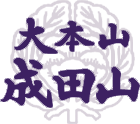
Daihonzan Narita-san Shinsho-ji Temple
Address: 1 Narita, Narita City, Chiba Prefecture, 286-0023
Tel: 0476-22-2111 (Main line) Fax: 0476-24-2210
ACCESS
By Train
10 minutes on foot from Keisei Electric Railway Keisei Narita Station or JR Line Narita Station
○ Keisei Electric Railway
About 65 minutes by express from Ueno Station, about 8 minutes from Airport Terminal 2 Station
*There are trains all night round on New Year's Eve.
For more information, please check the Keisei Electric Railway website.
○ JR Line
Approx. 75 minutes from Tokyo Station on the Sobu Main Line Rapid Service, which goes directly to the Yokosuka Line
About 8 minutes from Airport Terminal 2 Station
*There are trains all night round on New Year's Eve.
Premises Map
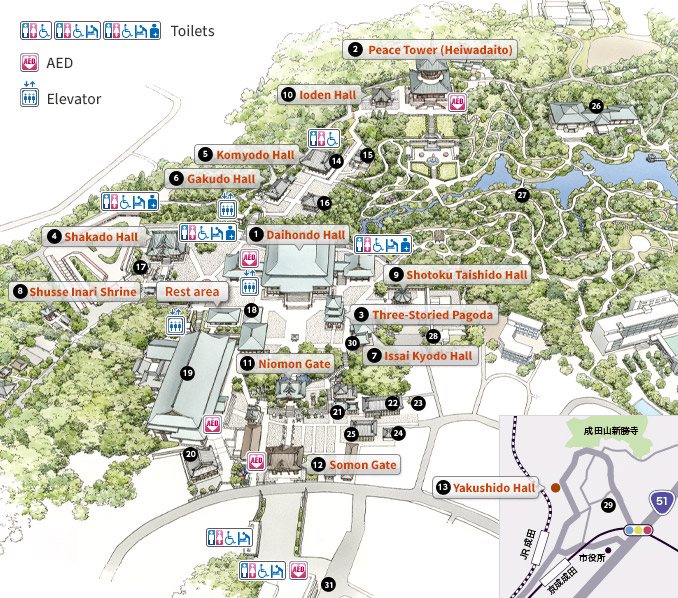
-
Daihondo Hall
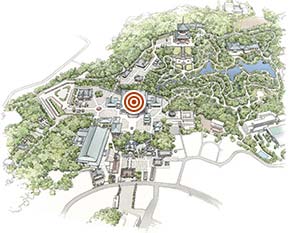
Built in 1968. Daihondo Hall is the central dojo of Naritasan Shinsho-ji Temple where the most prominent Ogoma Prayers are conducted. Statue of deity, Fudo Daimyo is in the spot followed by Kongara-doji on the right and Seitaka-doji on the left. In addition, the Four Great Myo-o and the Heisei Mandala are enshrined. Anyone can come in.Elevator for wheel chair is also available.
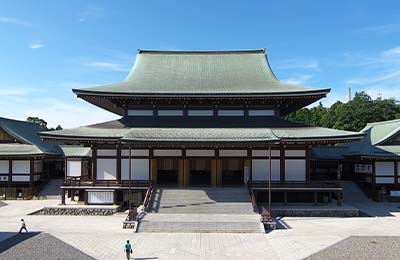
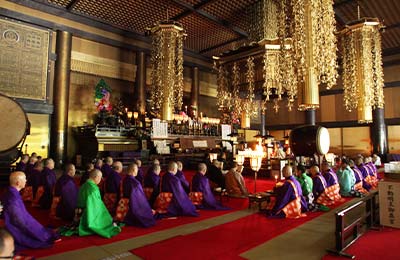
-
Peace TowerHeiwadaito
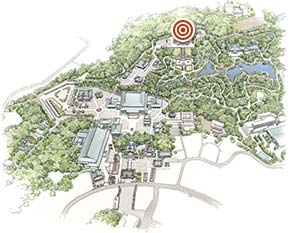
The Peace Tower build in 1984 is symbolizing the teachings of Shingon Esoteric Buddhism. The total height is 58m, and the entrance is on the 1st floor Reikoden Hall. There is a reception for Naritasan historical exhibition, Shakyo dojo and others. On the 2nd floor Myo-o-den, there are Big Five Myo-o, including the Statue of deity Fudo Myo-o, and Showa Dai Mandala, Shingon Soshi Gyojo-zu (a painting of the founder of Shingon belief) are enshrined.
On the 3rd floor Kyozoden Hall and the 4th floor Hozoden Hall, Buddhist statues are enshrined by believers. On the 5th floor Kongoden Hall, Gochinyarai (Five Wisdom Nryorai) are enshrined.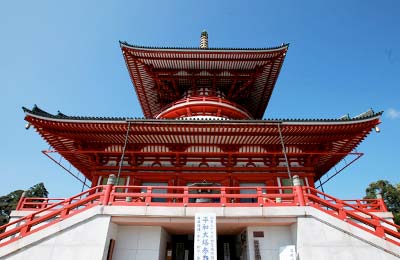
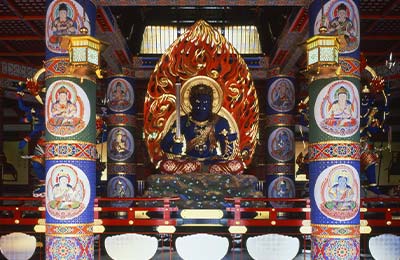
-
Three-Storied Pagoda
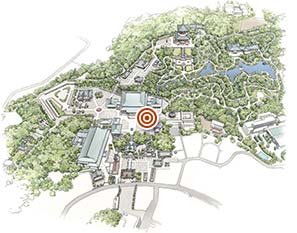
An important cultural property built in 1712. The total height is 25m. Centering Dainichi Nyorai, Five Wisdom Nyorais are enshrined. "16 arhats" are carved around them. Each layer of rafters carved with clouds and water are made from a solid timber. That is very rare and called single rafter.
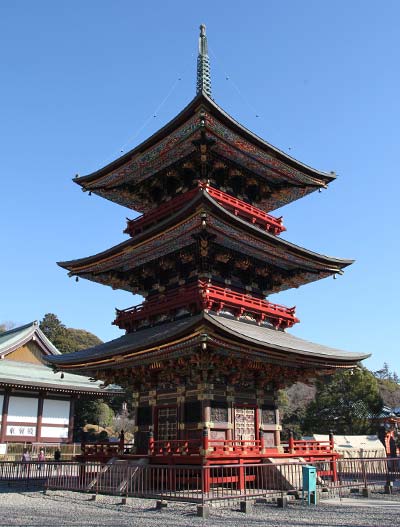
-
Shakado Hallshakado
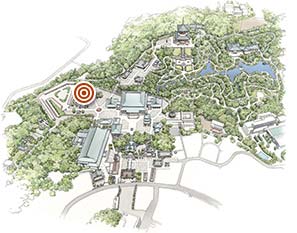
An important cultural property built in 1858. It is the former main hall, and it was removed to the current place in 1964 when Daihondo (Big Main Hall) was built. Founder of Buddhism and 4 Bosatsu; Shaka Nyorai, Fugen Bosatsu, Monju Bosatsu, Miroku Bosatsu and Senju Kannon are enshrined. Around them, "500 arhats" of many different sizes and shapes and "24 filial exemplars" of ancient Chinese story are carved. It is all-zelkova hall that retains late Edo period atmosphere finely. It is the prayer place for exorcism.
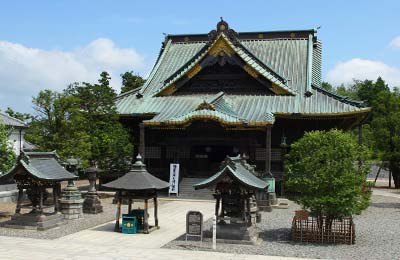
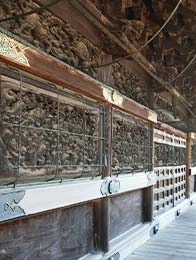
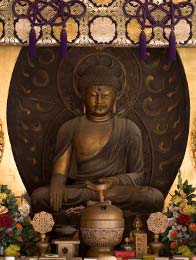
-
Komyodo Hall
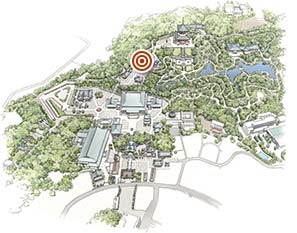
This is an important cultural property built in 1701. It was the main hall before Shakado Hall, and a valuable building during the Edo period. Dainichi Nyorai, Aizen Myo-o, and Fudo Myo-o are enshrined here. Behind them, there is a cave called Okunoin Hall, which is opened once a year during the Gion Festival in July.
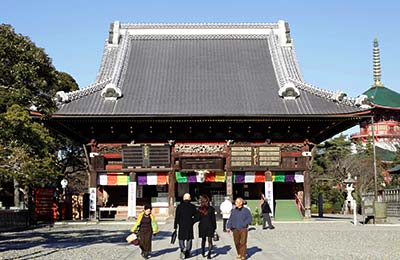
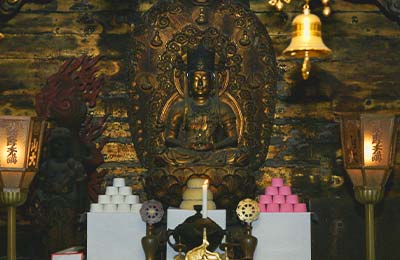
-
Gakudo Hall
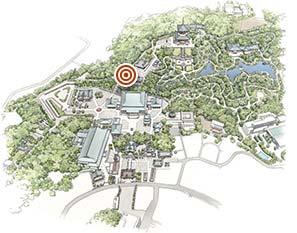
An important cultural property built in 1861 and restored in 1986. Frames and Pictorial offerings from believers are hung in this building and valuable pictorial offerings and carves of various kinds enshrined in Edo period are remarkable. In addition, there is a stone statue of Ichikawa Danjuro, the seventh generation who donated the first Gakudo (burned out by fire).
*The current Gakudo Hall was called the second Gakudo Hall until the first Gakudo Hall was burned down.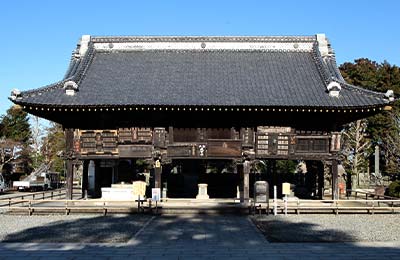
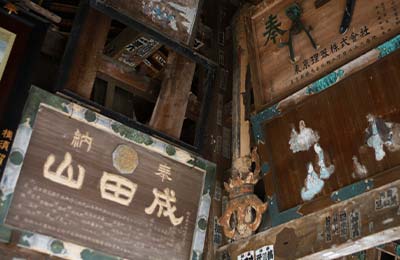
-
Issai Kyodo Hall
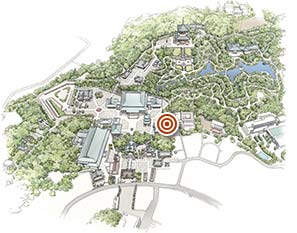
It was built in 1722 and has undergone many restorations in 1831, 1962, 1966, 1986, 1998 and 2009. It contains a rotating shelf for the sutra (about 2,000 volumes). The entrance sign above the door was written by Matsudaira Sandanobu, the grandson of Tokugawa Yoshimune (the 8th Edo Shogunate).
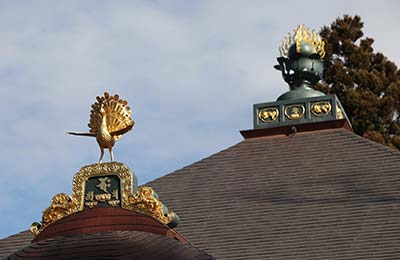
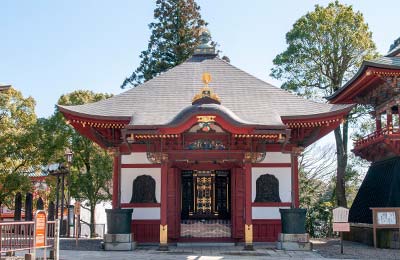
-
Shusse Inari Shrine
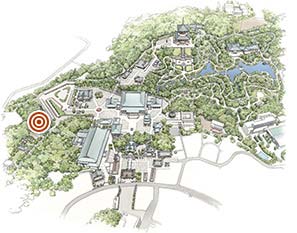
Facing the main building, go left and go upstairs, you will find Shusse Inari silently standing. The statue of deity was presented by Sakura feudal lord Inaba Masamichi ko who worshiped Naritasan piously in Edo period. It has been called upon as Shusse Inari since ancient times that has benefits of business prosperity, good luck fulfillment, and settling down fire.
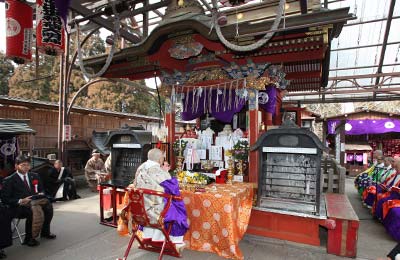
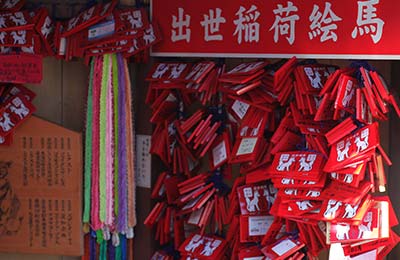
-
Shotoku Taishido Hall
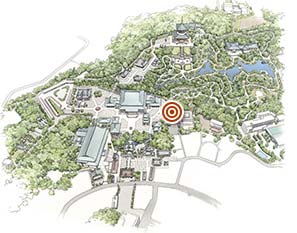
It was built in 1992 and restored in 2007. Based on the philosophy of Prince Shotoku Taishi, the father of Japan's rise of Buddhism. It was built for world peace. There are six mural paintings by Oyama Chusaku in the hall. The main statue is Shotoku Taishi, and the back Buddha is Shokanzeon Bosatsu (Bodhisattva).
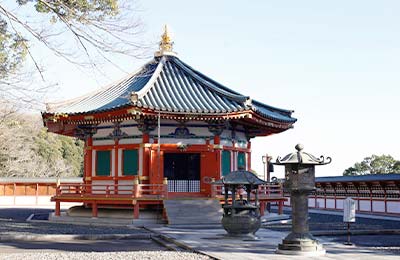
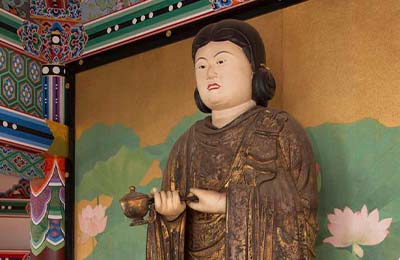
-
Ioden Hall
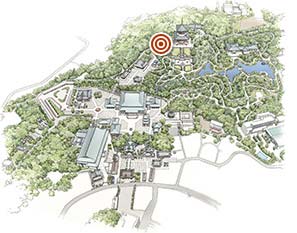
Built in 2017 as a commemorative project for the 1080th anniversary of Naritasan. All-cypress pyramid shaped hall. Yakushi Nyorai, Sunlight Nikkou Bosatsu, Moonlight Gekkou Bosatsu, and 12 Deity Warrior Shinshou are enshrined. It is a prayer place for healthy longevity and healing illness.
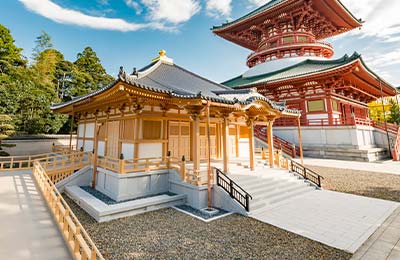
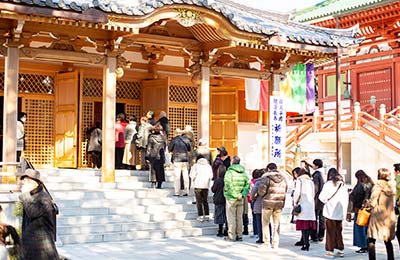
-
Niomon Gate
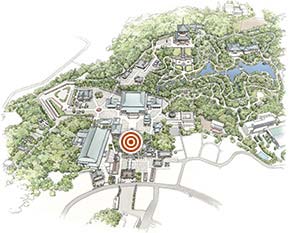
A national important cultural property restored in 1831. On the left and the right there enshrined 2 deities Misshaku Kongo and Karaen Kongo. They have protected the entrance of Naritasan from the ancient times. And Koumokuten and Tamonten are enshrined as the back Buddah. There written "Uogashi; Fish Market" on the central big lantern, it was dedicated by a group of believers of fish market in Tokyo.
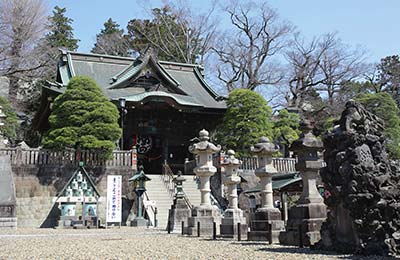
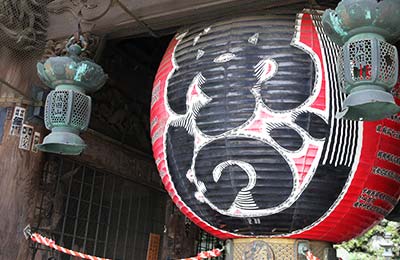
-
Somon Gate
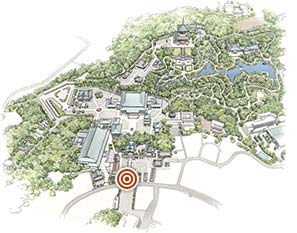
Built in 2008 as a commemoration project for 1070th anniversary of Naritasan. 15m height of all-zelkova building, at the transom window there is 12 zodiac wood carving. On the upper floor in the sublime atmosphere, there enshrined 8 of the gurdian deities, each from different years. As for the main entrance of Naritasan, we welcome many visitors.
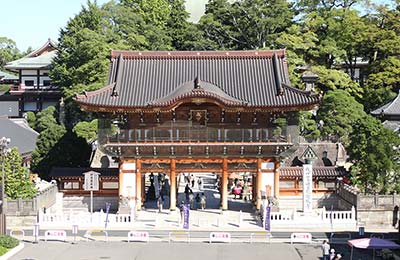
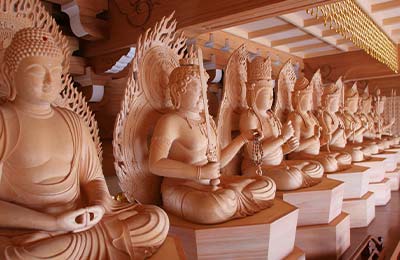
-
Yakushido HallYakushido
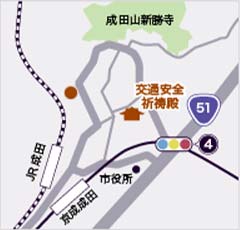
Former main hall built in 1655 in early Edo period, Shogun Tokugawa Mitsukuni and Ichikawa Danjuro the first paid a visit here. The oldest surviving hall in Naritasan. For 1080th year anniversary of Naritasan, the premises were renovated and the hall was restored.
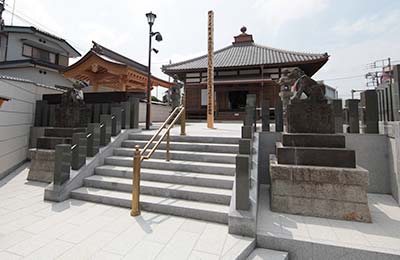
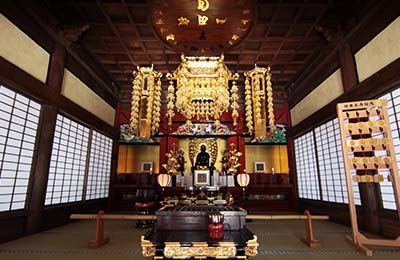
-
14
Okunoin Hall
-
15
SeiryuGongendo Hall
-
16
Kaisando Hall
-
17
Shotendo Hall
-
18
Good luck charm / Ogoma reception area
-
19
Korinkaku Hall
-
20
Daishido Hall
-
21
Suigyodo Hall
-
22
Sanrodo Hall
-
23
Shuho Dojo
-
24
Amidado Hall
-
25
Fasting Hall (Danjikido)
-
26
Calligraphy Museum
-
27
Naritasan Park
-
28
Buddhism Library
-
29
Traffic Safety Prayer Hall
-
30
Bell Tower (Shoro)
-
31
Shinto Kaikan Hall
Toilets
- Inside the Shinto Kaikan Hall
- In front of the Shinto Kaikan Hall
- The left side behind the Daihondo Hall
- The right side behind the Daihondo Hall
- The back of the Komyodo Hall
AED
- Korinkaku Hall
- Ogoma reception
- Daihondo Hall
- Peace Tower (Heiwadaito)
Elevator
- Korinkaku Hall lower parking lot
- Daihondo Hall
- The back of the Daihondo Hall
How to Worship
Here are some common ways to worship. There is no “specific” way of worship, so please see it as an example.
-
1
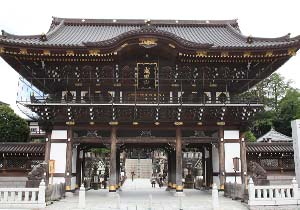
Bow at the gate
Enter the precincts from the Somon Gate. Because it is the Fudo deity's garden, bow before entering.
-
2
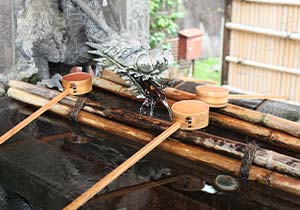
Cleanse for hands and mouth at the water purification place.
Go through the main gate, there is a water purification place in front of the stairs on the right. After scooping water by the ladle and pour it on your left and right hands, have water on your palm and rinse your mouth so that whole body and mouth be purified.
-
3
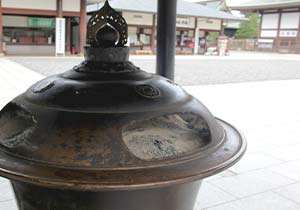
Purify your spirit with Kokaku
When you go through Niomon Gate and go up stairs, you see the Daihondo Hall (the main hall). At in front of the Main Hall, purify your body with the smoke from the Kokaku. It is beneficial for your mal-functioning body parts to have smoke while wishing for improving physical condition.
-
4
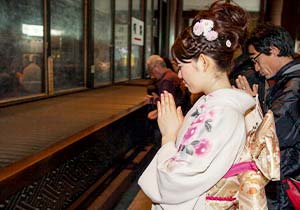
Praying hands at the Daihondo Hall
Please make a bow when you come in front of the offering box at the Daihondo Hall (the main hall). After you put in offering, pray with joining palms together, then make a bow once again.
-
5
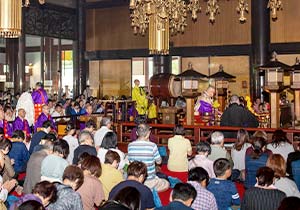
Worshiping the deity inside the hall
Please take your shoes and hat off and go in the hall. Make a bow at the Fudo deity in front, then pray with joining palms together.
After that make a bow once again. Not to make a noise in the hall nor photo shoot. -
6
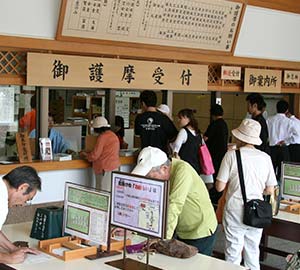
Applying for Ogoma prayer and good luck charm
There is Ogoma prayer reception on the left side of Niomon Gate, 1st floor of Korinkaku, left side of the Daihondo Hall (the main hall). Please choose from the wishes that suits you and fill in your name in the form and apply for it.
In addition, at both sides of Daihondo Hall (the main hall) west wing and east wing, there are amulet receptions on the left. By wearing the amulet of the deity spirit for protection, you have blessings from the Fudo deity every day.